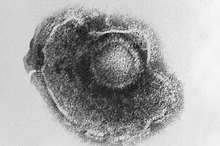Facial Herpes Symptoms
Herpes is a family of highly contagious viral infections. A form of the disease, varicella, causes chickenpox and shingles. Another form, herpes simplex virus type 1, or HSV-1, is the usual cause of herpes infections above the waist, including oral herpes. Herpes simplex virus type 2, or HSV-2, is usually the cause of genital herpes. All three herpes types can cause facial symptoms.
If you are experiencing serious medical symptoms, seek emergency treatment immediately.
Oral Herpes
Called “cold sores” and “fever blisters,” oral herpes can infect the lips, the hard surfaces inside the mouth and around the outside of the mouth 1. Less often, the blisters can appear on the cheeks, chin, neck and nose. The usual culprit in oral herpes infections is HSV-1, though HSV-2 can sometimes cause oral herpes as well. Medline Plus reports that more than half of the United States population is infected with HSV-1 by the time they reach their twenties 13. Kissing can transfer the disease from one person to another, though it can also be transferred from another area on the body, via the fingers, to the face. The virus lies dormant in the body and can reappear at any time. The first symptom that an outbreak is going to occur, called the “prodrome,” or “tingling stage,” is a tingling feeling in the spot where a lesion will appear. The “blister stage” follows, with one or more fluid-filled blisters forming and lasting about two days. The “weeping” or “ulcer” stage lasts about one day. During this time, the blisters break open and the liquid leaks out. This is the most contagious stage. The “scabbing stage” lasts two to three days. During that time the lesions crust and scab. The final stage is the “healing stage.”
- Called “cold sores” and “fever blisters,” oral herpes can infect the lips, the hard surfaces inside the mouth and around the outside of the mouth 1.
- The first symptom that an outbreak is going to occur, called the “prodrome,” or “tingling stage,” is a tingling feeling in the spot where a lesion will appear.
Shingles
First Outbreak Symptoms of Mouth Herpes
Learn More
When a person has had chickenpox, he will usually not have another chickenpox outbreak in his lifetime. The virus hibernates in the body, however, and can reactivate at a later time as herpes zoster, or shingles. The Mayo Clinic reports that shingles most often affects those over that age of 50. The reason for this may be a declining ability to keep the infection under control. Shingles blisters usually occur on just one side of the body, most often on the trunk or face. The first indications that an outbreak may occur are pain, sometimes even intense pain, burning, numbness or tingling of the skin. A few days later, a red rash may appear on the spot. Fluid-filled blisters grow, weep and crust over before healing. Fever and general malaise may accompany the symptoms. The blisters, when they do appear, often appear in a line or band.
- When a person has had chickenpox, he will usually not have another chickenpox outbreak in his lifetime.
- The blisters, when they do appear, often appear in a line or band.
Herpes Zoster Oticus
Formerly known as Ramsay Hunt Syndrome II, herpes zoster oticus is a complication of shingles 2. It occurs when the disease spreads to the facial nerves. The Cleveland Clinic reports that symptoms of herpes zoster oticus include intense ear pain and a rash that can surround the ear, mouth, face, neck and scalp 2. Paralysis of the facial nerves can occur, as well as tinnitus, vertigo, hearing loss, loss of taste, and dryness of the eyes and mouth. The prognosis for herpes zoster oticus is generally good, though hearing loss and facial paralysis may be permanent 2.
Related Articles
References
- Medline Plus: Cold Sores
- Cleveland Clinic: Herpes Zoster Oticus
- Medline Plus: Shingles
- Update for Patients: Chickenpox Overview
- Wareham DW, Breuer J. Herpes zoster. BMJ. 2007;334(7605):1211–1215. doi:10.1136/bmj.39206.571042.AE
- Volpi A, Gatti A, Pica F, Bellino S, Marsella L, Sabato A. Clinical and psychosocial correlates of post-herpetic neuralgia. Journal of Medical Virology. 2008;80(9):1646-1652. doi:10.1002/jmv.21254
- Jianbo W, Koshy E, Mengting L, Kumar H. Epidemiology, treatment and prevention of herpes zoster: A comprehensive review. Indian Journal of Dermatology, Venereology, and Leprology. 2018;0(0):0. doi:10.4103/ijdvl.ijdvl_1021_16
- Gilden D. et al. (2011) Review: The Neurobiology of Varicella Zoster Virus Infection. Neuropathol Appl Neurobiol.37(5):441-63.
- Shapiro M et al. (2011) Update on Herpes Zoster Vaccination: a Family Practitioner's Guide. Can Fam Physician. 57(10):1127-31.
Writer Bio
Katherine Mariaca is a professional freelance journalist who specializes in alternative and complementary medicine, and skin and body care treatments. A longtime spa director and VP of skin care companies, Mariaca developed products and services for the spa industry. She earned a B.S. from Tufts and an M.F.A. from Lesley.



